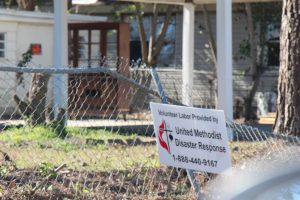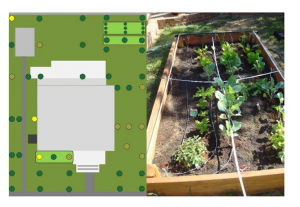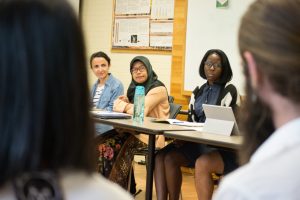Projects
Why do we do it? Let us count the reasons...
RESEARCH THEME: RESOURCE EQUITY
Energy poverty-climate justice – description forthcoming.
Resourcing resilience social-spatial coordination after disaster – description forthcoming.
Data, environment, and justice – description forthcoming.

Building Resilience through Innovation and Diverse Engagement (BRIDGE): Long-term recovery from Hurricane Matthew – Why we do it: Hurricanes and other disasters are often driven by weather, but preparedness, response, and recovery are inherently social processes. Although it is essential to sustainability, we don’t yet know what policy arrangements and social relationships are essential to rebuilding in ways that address long-standing social inequalities and environmental threats. We aim to integrate techniques that use new media and citizen science with large-scale geospatial and social network analysis approaches that can inform transformation and builds justice and resilience. By capturing these perspectives and sharing them widely, we aim to help communities and agencies learn lessons from one another. To paraphrase one resident “we don’t need to know what is going on in other towns cleaning up from Hurricane Matthew. We need to know what people recovering from Hurricane Katrina would have done differently.” Are you wondering what what interventions allow communities to become more just and sustainable following disasters? We are too! Key words: environmental justice, disaster recovery, resilience, social network analysis, watershed planning, design, Hurricane Matthew, Hurricane Florence. Project dates: 2016-2022.
Foreclosure as Landscape Change – Why we do it: The foreclosure crisis of 2008/2009 may seem like a long time ago, but we don’t yet know whether the ways that people, municipalities, and banks reacted is likely to lead to dramatic changes in the ways people think about the nature of cities or whether the measures taken to combat nuisance properties and promote urban greening are likely to reinscribe racist housing policies on affected neighborhoods. We aim to use geospatial, ecological, and social science methods to know how foreclosure, bank ownership, and desertion affected conditions in neighborhoods and whether the emergence and enforcement of city ordinances is likely to change vegetation and the role it plays in urban politics. Are you wondering what long-term changes may have been initiated after the foreclosure crisis? We are too! Key words: tree cover, remote sensing, vacant lots, home foreclosure, nuisance vegetation, geospatial analysis, participant observation, Phoenix, Arizona, Cleveland, Ohio. Project dates: 2013-2018.
Social Justice Following Stream Remediation – Why we do it: When social science claims to be completely “neutral” it implicitly reinforces the status quo. We aim to use the tools of social science in support of a future we can believe in: one that supports a healthy environment, economy, and society. Are you curious about whether environmental improvement projects also address social justice? Are you interested in what happens when researchers created documentaries from interviews instead of keeping the results private? We are too! Key words: Video, Interviews, Social Vulnerability, Mapping, Documentary, Milwaukee, Wisconsin, Hammond, Indiana, Areas of Concern, stream remediation, environmental justice. Project dates: 2013-2015

Soil Lead and Urban Gardening – Why we do it: Connecting people’s health and well-being to the environment means establishing positive relationships to the areas where they live, work, and play. Community organizing, civic pride, healthy eating habits, physical activity, and environmental awareness are all potential positive outcomes of engagement in urban gardening. However, legacies of pollution mean that urban soils are often more hazardous than those in more rural areas. We aim to use ecological tools to measure lead risk in urban soils and social science methods to evaluate resident motivation for urban gardening and the ways people organize to amplify environmental benefits and overcome environmental burdens. Are you curious about how residents and city leaders think about both the good (urban gardens) and the bad (urban soil lead) as they pursue a better future? We are too! Key words: soil, Pb, urban garden, community-university partnership, interview, video, social survey, Sacramento, California. Project dates: 2011-2016
RESEARCH THEME: THE SCIENCE-POLICY NEXUS

Social Dimensions of Restoration and Ecosystem Services – Why we do it: Public lands serve diverse public interests through recreation, conservation, and their use by grazing permittees, but it is difficult to account for the full range of public interests and public good in management. Defining what counts as good for the public is difficult as populations change and consumption levels climb. There is more pressure on today’s public lands to serve the public good today than at anytime in the past. We aim to integrate social science with ecological sciences to inform management aimed at restoration of ecosystem functions and cultural identities. Are you interested in knowing whether it is worth it to apply herbicides in order to improve biodiversity? Are you curious about whether technology can disrupt how managers and scientists think about landscapes to lead them toward new solutions? We are too! Key words: Q-method, ecosystem services, Restore New Mexico, social surveys, interviews, participatory GIS, photo-elicitation. Project dates: 2016-2020
TEACHING THEME: UNDISCIPLINED SUSTAINABILITY

“Citizenship” science for a sustainable future – Why we do it: Teaching students to solve sustainability challenges means training them to see negative spaces and connections that others have missed. Not just so that they can master the content over the lifespan of the course, but so that they position themselves as lifelong learners capable of thinking on the fly, evaluating the strength of evidence for and against different measures, and making decisions in the face of uncertainty. This includes teaching students about the ways that they can exert power through personal behaviors, professional choices, and civic engagement. Increasingly, this involves thinking about both their embodied and virtual interactions with the world. Are you curious about how social and spatial relationships complicate natural resource management? Want to know more about why the “rational actor” model of human behavior is insufficient? Curious about whether sustainability requires a new kind of science? We are too! Key words: PRTM 795/ GIS 595: Social Networks and Natural Resources Management, NR 303: Humans & the Environment, NR 595: Interdisciplinary Approaches to Sustainability Science, PRT 451: Recreation Planning and Facilities Development, PRT 203: Humans and the Environment. Project dates: 2016-present